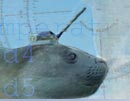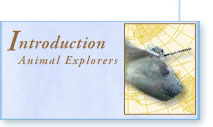| SEaOS: key points |
- SEaOS (Southern Elephant Seals as Oceanographic Samplers) is an international inter-disciplinary program aimed at increasing our understanding of how southern elephant seals interact with their physical environment.
- Specially developed instruments deployed on southern elephant seals have provided accurate temperature and salinity data from the Southern Ocean.
- Collaborators include oceanographers and biologists from Australia, France, the United States and the United Kingdom.
- The primary aim of the project is to demonstrate convincingly that we can use marine mammals to carry instruments to obtain "CTD" (conductivity - temperature - depth) profiles at high frequency, and in near real-time from remote, relatively inaccessible parts of the ocean.
[see Results]
- We use custom-built satellite linked recorders mounted on Southern elephant seals to provide CTD profiles from key areas within the Southern Ocean, such as the Antarctic sea ice zone, and frontal systems within the Antarctic Circumpolar Circulation.
[see Technology]
- In principal, this is an extremely cost-effective means of adding to existing global oceanographic data archives. It has the potential to complement existing sampling methods, especially for regions and times from which data are scarce and where these alternative methods may be difficult or prohibitively expensive to implement.
- Near real-time data obtained will also allow us to explore the links between seal behaviour, foraging activity, and oceanographic features, such as frontal systems, local eddies and thermoclines.
|
|
Our project grew from the desire for better understanding of the life and biology of the Southern Elephant Seal. Through improving our own knowledge of their behaviour and habits, and of the environment in which they live, we hoped to gain better insights into how to conserve and protect these top level marine predators.
In the process of this study, elephant seals have begun to teach us more than we might have anticipated. In studying the journeys of these natural explorers of the Antarctic, we have recorded information about more than habits, depths, and distances. We have also expanded our understanding of the connection between the ocean, global climate dynamics, and the influence of human activities.  As a consequence the SEaOS project is a truly interdisciplinary one, bringing together the interests of biologists studying living systems, and oceanographers studying marine physics. As a consequence the SEaOS project is a truly interdisciplinary one, bringing together the interests of biologists studying living systems, and oceanographers studying marine physics.
The long maritime expeditions of the Southern Elephant Seals have yielded data which is important to both types of scientist, and given a clear indication of the intimate connections between the mechanics of the Earth’s oceans, and the complex ecosystems which dwell within and upon them.
|




![]()
 As a consequence the SEaOS project is a truly interdisciplinary one, bringing together the interests of biologists studying living systems, and oceanographers studying marine physics.
As a consequence the SEaOS project is a truly interdisciplinary one, bringing together the interests of biologists studying living systems, and oceanographers studying marine physics.